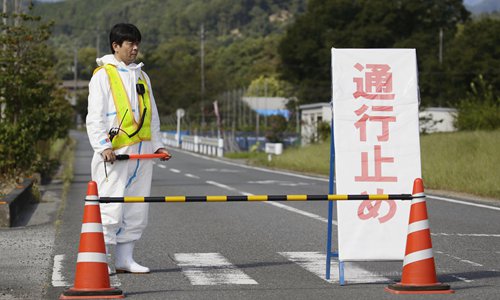HOME >> BUSINESS
A global battle against African swine fever
Source:Global Times Published: 2019/9/18 18:28:40
Disease hard to control with frequent global personnel exchanges, animal transportation

Workers in hazmat suits sterilize a street with caustic lime near a pig farm in Chichibu, Saitama Prefecture, eastern Japan, on Saturday. Photos: IC
A case of African swine fever (ASF) in South Korea on Tuesday shows that the disease has spread further into the Asian continent despite strengthened monitoring efforts, while also indicating the long-lasting battle with the virus is more difficult than had been expected.Kim Hyun-soo, South Korea's agricultural minister, confirmed the country's first ASF case on Tuesday, after several pigs that died at a farm in the city of Paju, Gyeonggi Province, were found to have been infected with the virus.
In response, the South Korean government has raised the animal disease alert to the highest level, "severe," and has issued a lockdown on the movement of pigs across the country to prevent the disease from spreading further, Kim said at a press conference on Tuesday.
According to a definition from the Food and Agriculture Organization of the United Nations (FAO), the ASF virus is a fatal animal disease affecting pigs and wild boars with up to a 100-percent fatality rate. There is no known cure thus far, and it is not dangerous to humans.
South Korea is the latest country affected by ASF in Asia, where the rampant disease, also referred to as "pig Ebola," has been spreading rapidly. Other nations affected in the region include Japan, Mongolia, Cambodia, North Korea and China.
Asia outbreak
The Global Times has summarized the timeline and current ASF situation across the world, notably in Asia from August 2018, based on information from the FAO, media reports and government websites.
China: China confirmed its first ASF outbreak in Northeast China's Liaoning Province on August 3, 2018. As of September 12 this year, 157 ASF outbreaks have been detected across the country. About 1.17 million pigs have been culled in an effort to halt further spread.
Mongolia: Mongolia first reported an ASF case on January 15, 2019. As of September 12, 11 outbreaks in six provinces and in Ulaanbaatar have been reported, involving 105 farms and households. More than 3,115 pigs, accounting for about 10 percent of the total pig population in the country, have died or have been slaughtered due to the disease.
Vietnam: Since confirming its first ASF outbreak on February 19, a total of 63 provinces and cities have reported outbreaks. More than 4.7 million pigs have been culled.
Cambodia: Since confirming the first ASF outbreak in Ratanakiri Province on April 2, ASF outbreaks were detected in 5 provinces across the country.
North Korea: North Korea confirmed its first ASF outbreak in Chagang-Do on May 23.
Laos: Since confirmation of the first ASF outbreak in Salavan Province on June 20, a total of 94 ASF outbreaks have been reported in Laos in 15 out of its 18 provinces and cities. More than 25,000 pigs have died or been slaughtered due to ASF.
Myanmar: Since confirming its first ASF outbreak on August 1, a total of three ASF outbreaks have been reported in Shan State.
Japan: Japanese officials have culled 753 pigs in the Saitama Prefecture, north of Tokyo, after detecting an outbreak of the swine fever on September 15.
Apart from the large-scale outbreak in Asian countries, ASF has also hit Russia and some European countries in the past year, as global ASF outbreaks have increased by about 25 percent year-on-year, according to media reports.
And the virus is still spreading. The thus far unaffected North American area is strengthening its preventative measures. The US Department of Agriculture (USDA) is furthering its overall ASF preparation efforts with the implementation of a surveillance plan.
As part of this plan, the Animal and Plant Health Inspection Service will work with the swine industry, the states and veterinary diagnostic laboratories to test for ASF, according to the USDA official website on May 16.

A road is closed near a pig farm in Chichibu, Saitama Prefecture, eastern Japan, on Saturday.
A global headacheWang Zuli, a research fellow with the Chinese Academy of Agricultural Sciences who closely follows the ASF situation in China, told the Global Times on Tuesday that the rapid spread of the disease across Asia is partly due to frequent personnel and product exchanges amid the rapid development of globalization over the past decade.
As there is no cure or vaccine, countries can only prevent the disease by taking protective measures, such as the implementation of appropriate import policies and biosecurity measures, ensuring that neither infected live pigs nor pork products are introduced into areas free of ASF, Wang said.
The only way to control ASF is to slaughter all animals that have been infected or potentially exposed, Wang added.
Furthermore, transmission can also occur via contaminated feed and fomites (non-living objects) such as shoes, clothes, vehicles, knives and equipment, making ASF control and prevention very difficult between neighboring countries, Wang noted.
According to media reports, after the world's first ASF case occured in Kenya, Africa, in 1921, outbreaks have been reported in more than 60 countries around the world.
Once ASF breaks out, different countries have varying abilities to cope with the situation, with different external environments and movement of live or dead pigs, Wang said.
Thus far, only 13 countries have eradicated ASF. ASF in countries such as Cuba, Belgium and France has been eliminated once and then re-occurred again, according to the Ministry of Agriculture and Rural Affairs of China.
ASF in China
China confirmed its first ASF outbreak in Northeast China's Liaoning Province on August 3, 2018. The world's largest pig producer has reported cases over a large swath of the country.
Actions taken by China include the release of a 2019 edition of the ASF Epidemic Emergency Implementation Plan in January, which updated regulations that ruled if ASF is detected, the factory in question should stop production for 48 hours and then apply for an evaluation to resume production.
On September 3, China released a notice to stabilize pig production, introducing measures including the provision of subsidies for mandatory culling due to ASF, and the facilitation of temporary loans for breeding and large-scale pig farms.
"Now, the situation is generally under control, and China has accumulated lots of experience that could prevent ASF from spreading further," Wang said, adding that major enterprises in China already have the ability to contain the disease, while small farms might be more vulnerable to the virus.
Wang noted the rising price of pork in the country, which surged by 46.7 percent year-on-year in August, according to China's National Bureau of Statistics, will remain elevated for at least half a year.
"The large-scale outbreak of ASF in Asia will not largely affect domestic pork supply, since other Asian countries have relatively small production [capacity] compared with China," Wang said,
On Tuesday, China announced the release of a total of 10,000 tons of frozen pork from the central reserve onto the market, according to the website of the China Merchandise Reserve Management Center.
Posted in: ECONOMY